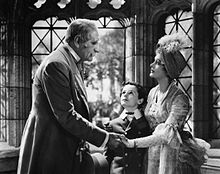Sophie Wachner (November 5, 1879 – September 13, 1960) was an American costumer who designed costumes for Metro-Goldwyn-Mayer, Fox, and Selznick International Pictures in the early 20th century.[1][3][4] Her work appeared in films such as Just Imagine, A Connecticut Yankee, and Little Lord Fauntleroy.[5]
Sophie Wachner | |
|---|---|
 C. Aubrey Smith, Freddie Bartholomew & Dolores Costello in Little Lord Fauntleroy | |
| Born | November 5, 1879[1] |
| Died | September 13, 1960 (aged 80)[1] |
| Nationality | American |
| Known for | Costume design |
| Notable work | He Who Gets Slapped, Just Imagine, A Connecticut Yankee |
| Spouse |
Harold Powers
(m. 1920; died 1943) |
Early life
editWachner was born in 1879 in Akron, Ohio, to Jewish immigrant parents from Hungary.[1] She first began a career in teaching in Akron Public Schools, but in 1909 moved to New York City to design costumes on Broadway.[3] She and her aunt, Frederica De Wolfe, spent ten years there, and during this time Wachner worked as a costumer for Florenz Ziegfeld Jr.[3] In 1919, she moved to Los Angeles to work for Goldwyn Studios.[1]
Career
editWachner joined Goldwyn Studios in August 1919, as they set up a new headquarters for their costume department.[6] Wachner was well-known among the Los Angeles clothiers who supplied Goldwyn Studios' productions.[7][8] While employed there, Wachner's opinion was greatly respected by the actors and directors she worked with, who "court[ed] her favor exactly as they court the favor of the public".[9] William Wellman and G. B. Manly gave her the nickname 'Colonel Wachner'.[10] Her early work for Goldwyn included costumes for the Hobart Henley film So This Is Marriage, which included a technicolor sequence depicting the story of Bathsheba and David, and He Who Gets Slapped, a 1924 psychological thriller starring Lon Chaney.[11] For the 1930 film Just Imagine, she collaborated with Alice O'Neill and Dolly Tree to create a wardrobe for futuristic 1980s New Yorkers and Martians.[1] Wachner left Goldwyn Studios for Fox in 1924, and worked there until 1930, when she was fired to cut costs.[3][12] Wachner worked in Hollywood for over fifteen years, with her final film Little Lord Fauntleroy being released in 1936.[5]
Filmography
editReferences
edit- ^ a b c d e f g Jorgensen, Jay; Scoggins, Donald L. (6 October 2015). Creating the illusion : a fashionable history of Hollywood costume designers. Philadelphia: Hachette. p. 14. ISBN 9780762458073.
- ^ "Studio News". Los Angeles Herald. 8 September 1920. Retrieved 30 September 2020.
- ^ a b c d Fischel, Jack R. (2009). Encyclopedia of Jewish American popular culture. Westport, Conn.: Greenwood Press. p. 113. ISBN 9780313087349.
- ^ Wilk, Ralph (23 November 1935). "A little from "lots"". The Film Daily. Retrieved 6 September 2020.
- ^ a b "Wachner, Sophie", AFI Catalog, American Film Institute
- ^ "News in sub-titles". The Studio Skeleton. 1 (7): 3. 2 August 1919. Retrieved 7 September 2020.
- ^ Heustis, Reed (22 September 1919). "Beauty, talent, and pork are located at Goldwyn Studio". Los Angeles Herald. Retrieved 7 September 2020.
- ^ "Tall, slender girls have their inning". Madera Tribune. 25 October 1922. Retrieved 7 September 2020.
- ^ Prophater, Anna (December 1923). "Hidden hands of filmdom". Screenland. Retrieved 6 September 2020.
- ^ "Shoot!". The Studio Skeleton. 1 (16): 3. 4 October 1919. Retrieved 7 September 2020.
- ^ "Elaborate biblical scenes to be made in color for Metro Production". American Cinematographer. 4: 13. November 1924. Retrieved 6 September 2020.
- ^ Maclean, Adrianne L. (7 October 2016). Costume, makeup, and hair. New Brunswick, New Jersey: Rutgers University Press. pp. 27–30. ISBN 9780813571539.